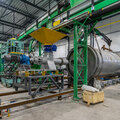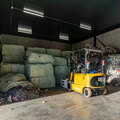In a world grappling with the consequences of excessive plastic consumption and soaring greenhouse gas emissions, innovative solutions are needed to address the dual crises of environmental pollution and climate change. Plastic pyrolysis emerges as a transformative technology, holding the promise of reducing global emissions while simultaneously addressing the ever-growing issue of plastic waste.
Understanding the Plastic Problem:
Before delving into the intricacies of plastic pyrolysis plant and its impact on global emissions, it's crucial to comprehend the scale of the plastic predicament. Plastics have become an integral part of modern life, providing convenience in packaging, manufacturing, and various consumer products. However, the flip side of this convenience is a mounting environmental crisis.
Plastic waste, often disposed of improperly, litters landscapes, contaminates oceans, and poses a severe threat to wildlife. Moreover, the production of plastics is inherently linked to the consumption of fossil fuels, contributing significantly to greenhouse gas emissions. It's a vicious cycle that demands a circular and sustainable approach to break free.

Enter Plastic Pyrolysis:
Plastic pyrolysis is a cutting-edge technology designed to tackle both the plastic waste epidemic and the global emissions crisis. At its core, pyrolysis is a process that involves the thermal decomposition of organic materials in the absence of oxygen. In the context of plastic, this means converting discarded plastic into valuable resources without the need for incineration.
The Process Unveiled:
The plastic pyrolysis process typically involves three main stages: feeding, pyrolysis, and condensation.
Feeding: Waste plastic, ranging from packaging materials to single-use items, is fed into a pyrolysis reactor.
Pyrolysis: The reactor subjects the plastic to high temperatures in the absence of oxygen, causing the plastic to break down into smaller hydrocarbons.
Condensation: The resulting hydrocarbons are then condensed into liquid fuel or other valuable by-products.
Breaking Down Emissions Reduction:
The emission reduction benefits of plastic pyrolysis are multifaceted and impactful. Here's a closer look at how this innovative technology contributes to a greener and more sustainable future:
Reducing Greenhouse Gas Emissions:
Plastic production is intricately linked with the extraction and refinement of fossil fuels. By diverting plastic waste from traditional disposal methods, such as landfills or incineration, plastic pyrolysis disrupts the linear process of fossil fuel consumption. This, in turn, helps cut down greenhouse gas emissions associated with both plastic production and waste management.
Mitigating Methane Emissions from Landfills:
When plastics end up in landfills, they contribute to the generation of methane, a potent greenhouse gas. Plastic pyrolysis offers a viable alternative, preventing plastics from decomposing anaerobically and releasing methane into the atmosphere.
Energy Recovery and Renewable Fuel Production:
One of the key by-products of plastic pyrolysis is a liquid fuel that can be used as an alternative to traditional fossil fuels. This not only reduces the reliance on non-renewable resources but also provides a sustainable energy source with a lower carbon footprint.
Closing the Plastic Loop:
The circular economy is gaining traction as a sustainable model for resource use. Plastic pyrolysis contributes to this model by creating a closed-loop system for plastics. Instead of being discarded, plastics are transformed into valuable resources, reducing the need for new plastic production and the associated emissions.
Addressing Plastic Pollution:
Beyond emission reduction, plastic pyrolysis directly addresses the issue of plastic pollution. By converting plastic waste into useful products, the process helps clean up the environment and prevents the long-term ecological damage caused by plastic debris.
Challenges and Considerations:
While the potential of plastic pyrolysis in emission reduction is undeniable, it's essential to acknowledge the challenges and considerations associated with its widespread adoption.

Technological Maturity:
The technology is still evolving, and achieving consistent and efficient outcomes across different types of plastics remains a challenge. Further research and development are necessary to optimize the process for diverse plastic compositions.
Economic Viability:
The economic viability of plastic pyrolysis is influenced by factors such as initial investment costs, energy input, and the market demand for the end products. Governments and industries need to explore policies and incentives that support the economic feasibility of plastic pyrolysis projects.
Regulatory Frameworks:
Clear and supportive regulatory frameworks are crucial for the successful integration of plastic pyrolysis into waste management systems. Regulations should address environmental standards, product quality, and the overall sustainability of the process.
Public Awareness and Perception:
The success of plastic pyrolysis also depends on public awareness and acceptance. Educating the public about the benefits of this technology and dispelling misconceptions is essential for fostering a positive perception.
Case Studies: Real-World Impact
Several initiatives around the globe showcase the real-world impact of plastic pyrolysis in reducing emissions and combating plastic pollution.
Neste's Plastic Waste-to-Fuel Project:
Neste, a Finnish energy company, has been at the forefront of converting plastic waste into renewable fuels. Their project demonstrates the potential of plastic pyrolysis in producing high-quality, low-emission fuels.
Plastic Energy's Advanced Recycling Plants:
Plastic Energy, a company specializing in advanced recycling technology, has developed several plants that convert end-of-life plastics into valuable oils. These oils can be used in the production of new plastics or as a source of energy, contributing to a circular economy.
Future Prospects and Concluding Thoughts:
As we stand at the intersection of environmental stewardship and technological innovation, plastic pyrolysis emerges as a beacon of hope in the quest for emission reduction and sustainable waste management. While challenges exist, ongoing research and collaborative efforts between governments, industries, and communities can pave the way for the widespread adoption of this transformative technology.
In the journey towards a cleaner, greener future, plastic pyrolysis stands as a testament to human ingenuity and the capacity to turn challenges into opportunities. By breaking the chains of conventional plastic disposal and emissions-intensive processes, we open the door to a more sustainable and harmonious relationship with the planet we call home. The time to embrace the potential of plastic pyrolysis is now, for the sake of our environment, our climate, and generations yet to come.





